Article's Content
If your brand depends on being found in search, GPT-5 should be on your radar. It’s faster, it can handle more complex reasoning, and it changes the way ChatGPT decides what content to show and who sees it.
According to Sam Altman, more than 700 million people use ChatGPT every week. With GPT-5, they can now access a reasoning model positioned as “PhD-level” for learning, creating, and working. For marketers, this release will influence how AI-powered tools shape brand discovery and customer decisions.
The rollout drew plenty of attention:
- Promises of the “most capable model yet” followed by two rounds of feature walk-backs
- Backlash over the removal of legacy models like GPT-4o and o3
- A viral moment where the “PhD in your pocket” couldn’t count the letters in strawberry
- A high-pressure AMA where OpenAI’s leadership faced pointed questions from users
While those moments captured headlines, the bigger story is the scale and speed of ChatGPT’s adoption. In just 32 months, it has gone from launch to one of the most widely used tools for online work, research, and decision-making. GPT-5 changes how the system works and handles the content people rely on to make those decisions.
What You Need to Know About the GPT 5 Release
According to OpenAI, the launch of GPT-5 marks the biggest shift yet for the company’s flagship model. The PhD in your pocket provides faster responses, more advanced reasoning capabilities, and a cleaner user experience. Each improvement can potentially influence how ChatGPT evaluates content, selects sources, and delivers information to users.
Here’s a high-level breakdown of the updates:
| Category | Details |
| New Models |
|
| Model Selection |
|
| Usage Limits |
|
| New Features |
|
| Tools Supported |
|
There have been several updates since the initial GPT-5 launch, and more may be on the way. The best place to keep tabs on the current features is through OpenAI’s ChatGPT release notes.
Now let’s look at some of the major changes to this frontier model:
GPT-5’s New System Architecture
With GPT-5, OpenAI has changed how people interact with their models in both ChatGPT and the API. Instead of requiring users to manually select the model, GPT-5 uses a unified system made up of three key components:
- GPT-5 Fast: A smart, efficient base model for most questions (Fast)
- GPT-5 Thinking: A deeper reasoning model for complex or multi-step problems
- GPT-5 Auto: A router decides which model to use based on the question’s complexity and user intent
After a few post-launch updates, OpenAI has moved the real-time routing into a GPT-5 Auto option under the model picker so users can maintain control over which version they use. But, according to Altman, this is the mode that “most users will want.”
When the GPT-5 Auto feature is turned on, ChatGPT will select the ideal model to answer the question. A user might start a conversation that requires answers from the Fast (not reasoning) model, but if the conversation leads to a question that requires reasoning, the system can switch to the Thinking model without any extra input.
This setup means a single query could be processed by different models depending on its depth. Content that’s clear, accurate, and comprehensive is more likely to be selected and cited when the system engages its deeper reasoning mode.
The reasoning process is visible to users:

Though there’s some contention about whether the stated decision-making process aligns with what happens on the back end, this transparency could help content creators identify patterns in the content GPT-5 pulls during web search.
Performance Benchmarks
Like other major model launches, GPT-5 was tested across coding, writing, reasoning, and academic benchmarks. OpenAI reports higher scores than previous models on most measures, including GPT-4o, o3, and Deep Research.
One of the most notable results comes from Humanity’s Last Exam, a 2,500-question test spanning topics from math and science to the humanities.

GPT-5 surpassed equivalent models like o3, 4o, and even Deep research.
Benchmarks also show improvements in factual accuracy. In internal testing, GPT-5 produced fewer hallucinations than GPT-4o and generated more consistent answers to open-ended questions.
For marketers, stronger reasoning and accuracy means ChatGPT may be better equipped to handle detailed, comparison-style queries — the kind where users evaluate products, services, or strategies before making a decision. Brands that publish clear, well-sourced, and comprehensive content are more likely to be surfaced in these deeper, more analytical answers.
According to SEO expert Lily Ray, it can even be more discerning when navigating searches that are typically gamed by service vendors:
Phasing Out Older Models (and Reinstating Them)
One of the most debated parts of the GPT-5 rollout was OpenAI’s decision to remove access to popular older models (that CEO Sam Altman publicly said he hated). At launch, GPT-4o, GPT-4.1, and o3 were deprecated, and existing chats were opened with the closest GPT-5 equivalent.
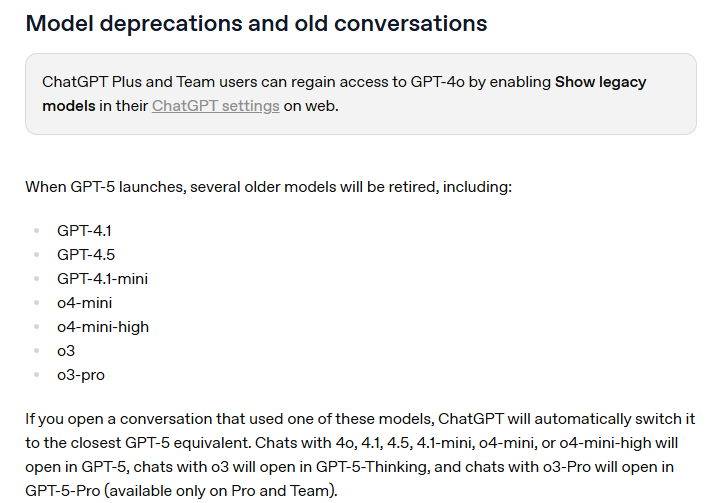
The company initially planned to limit users to a small set of GPT-5 versions without a manual selection option. But after strong pushback, OpenAI restored the model picker and made legacy models available again to paid users (more on that in a second).
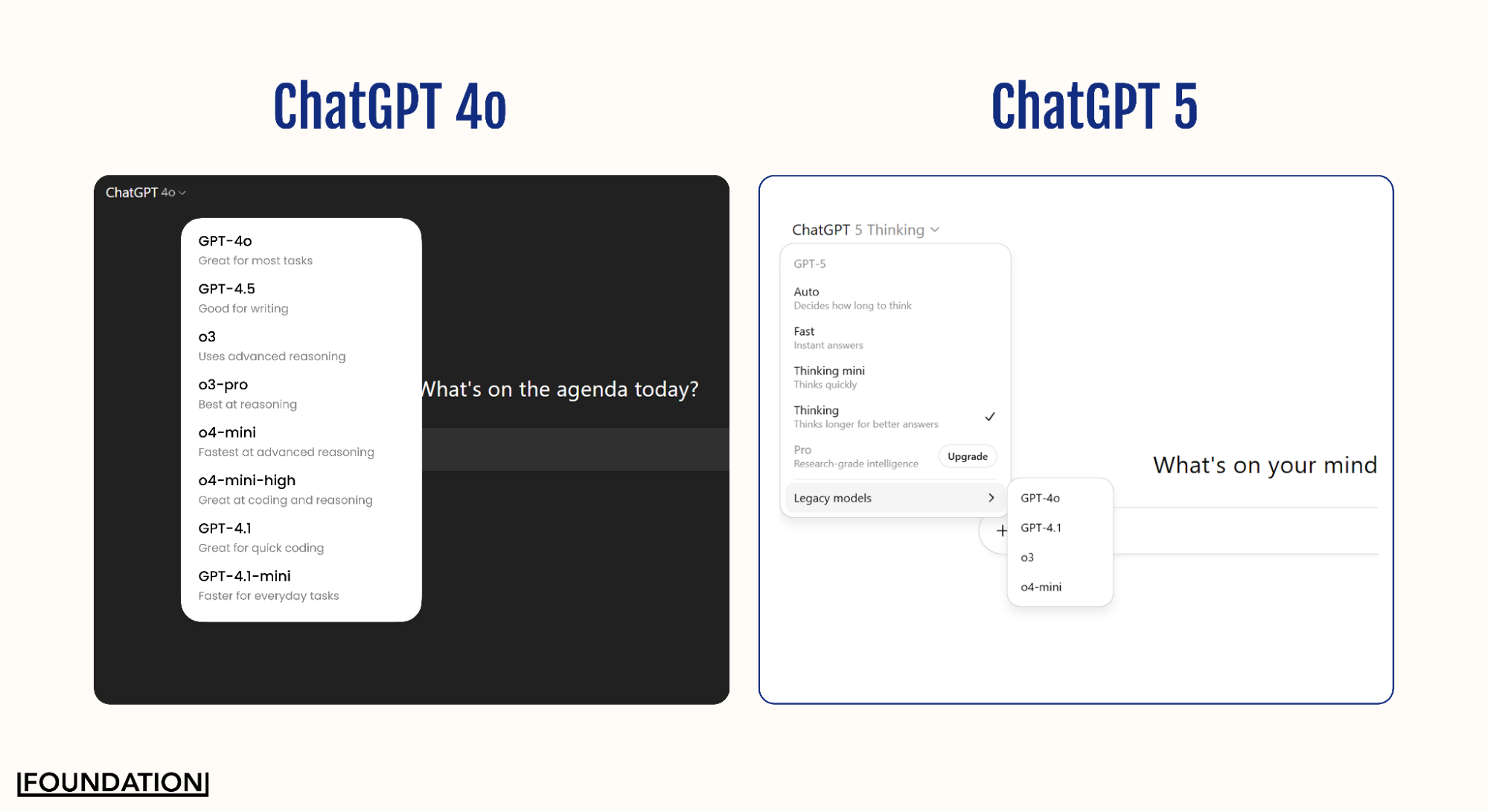
The initial announcement and rollback show the volatility of the AI search landscape. Testing content visibility across multiple versions — not just the newest one — is key to understanding how AI search changes over time.
Updates to ChatGPT:
You can now choose between “Auto”, “Fast”, and “Thinking” for GPT-5. Most users will want Auto, but the additional control will be useful for some people.
Rate limits are now 3,000 messages/week with GPT-5 Thinking, and then extra capacity on GPT-5 Thinking…
— Sam Altman (@sama) August 13, 2025
Despite the pivot, it seems OpenAI’s long-term goal is to move all users over to a specific selection of models. They even had GPT-5 write an eulogy for previous models during the initial launch video.
These changes to model availability were only part of the rollout. OpenAI also updated how tools work inside ChatGPT, removing friction and expanding integrations.
Tool Support and Web Search
In earlier versions of ChatGPT, certain tools like web browsing, image generation, and Python-based data analysis were tied to specific models. Users had to switch models to access them.
With GPT-5, all tools are available in one place. Web search, code interpreter, file analysis, image analysis, and other features can be used without changing models or losing conversation context.
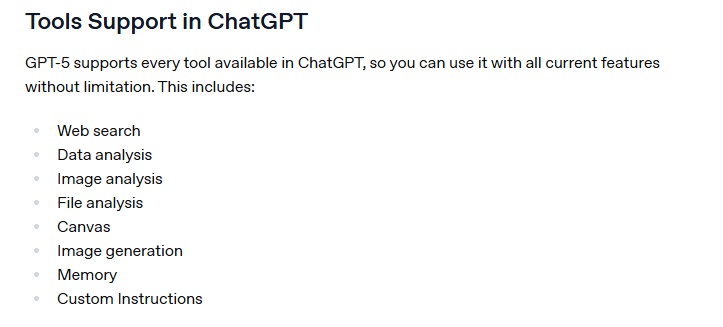
Internal tests also show that GPT-5 is 45% less likely than GPT-4o to produce factual errors when web search is enabled. From a marketing perspective, this could increase the importance of publishing accurate, well-sourced, high-EEAT content that AI systems can verify.
Gmail, Google Calendar, and Google Contacts integrations have also been added for Pro users, joining earlier connectors like HubSpot, Canva, and Dropbox. These integrations bring ChatGPT into more of the tools people already use, creating more opportunities for branded resources to appear in relevant contexts.
API Changes at a Glance
Alongside the ChatGPT updates, OpenAI released changes for developers using the API. These changes focus on controlling model behavior and performance. Key updates include:
- Model sizes: Three options let developers balance cost, speed, and quality, plus a chat-focused variant for lighter reasoning needs.
- Expanded context window: 400K-token capacity supports large projects. Hidden reasoning tokens still count toward the limit and cost money, so budgeting remains important.
- Granular controls: Adjust speed for faster responses or control how much explanation the model provides, reducing the need for complex prompt engineering.
- Enhanced tool calling: Accepts plain text instead of complex data formats, can run multiple tools at once, limits tool use, and provides status updates.
- Improved agentic behavior: Handles multi-step actions more reliably, follows complex instructions more accurately, and reduces the need for custom code in workflows and automation.
One of OpenAI’s stated goals is to reduce the complexity of building production AI applications. As Altman himself said, SaaS is entering its fast fashion era.

These changes have reshaped how GPT-5 works behind the scenes. The next question is how people feel about using it — and that’s where the early reactions get interesting.
Early Reception and Reactions to GPT-5
The reception to GPT-5 across media and social platforms was far from glowing. The GPT-5 launch triggered immediate (and very vocal) feedback from the ChatGPT community.
Users were distraught with the removal of older models and the discrepancy between the “PhD level agent in your pocket” and the initial results (most PhD candidates are aware that blueberry has two b’s and strawberry three r’s).
During OpenAI’s launch AMA, attended by Sam Altman and senior team members, these frustrations dominated the discussion. The immediate result was a partial reversal: GPT-4o and several legacy models returned for ChatGPT users, and the extent of automatic routing was scaled back.

Still, the possibility of losing models that people have used for years left many on high alert.
Aside from the frustrations around limiting model choice, performance reviews were mixed. Unsurprisingly, sentiment on Reddit runs the gamut from the new model being “horrible” and “awful” to “actually quite good”.
The unified interface and automatic routing complicated things further for free users, who had little visibility into which model they were getting at any given time.
The issue with GPT-5 in a nutshell is that unless you pay for model switching & know to use GPT-5 Thinking or Pro, when you ask “GPT-5” you sometimes get the best available AI & sometimes get one of the worst AIs available and it might even switch within a single conversation. pic.twitter.com/IfAJ7RIUgu
— Ethan Mollick (@emollick) August 9, 2025
For some, this lack of control looked less like streamlining and more like cost-cutting.
Yet even with launch fumbles and performance hiccups, optimism remains. GPT-5 is still in its first weeks, and OpenAI continues to refine it. Those who invest the time to learn its strengths — and how to work with it effectively — are most likely to benefit as the rollout matures.
What the GPT-5 Release Means for Search and Brand Discovery
The GPT-5 rollout is happening in the middle of a much larger conversation in the marketing space. Namely, the increasing use of AI-powered search through platforms like ChatGPT, Gemini, and Perplexity.
And for the first time, free ChatGPT users can access a reasoning model. Whether this changes adoption patterns remains to be seen, but with more than 700 million weekly users, the potential impact is hard to ignore.
Surveys show that 77% of ChatGPT users perform web searches in the app, and nearly a quarter use it as their first stop. That means GPT-5’s reasoning capabilities could influence where those searches lead — and which brands appear in the answers.
We’ve already seen how AI referrals from ChatGPT can drive high-intent traffic to brand sites. Earlier this year, form builder Tally saw a 25% increase in users thanks to referrals from ChatGPT.
While OpenAI hasn’t officially shared whether GPT-5 will change search behavior, alleged leaked system prompts offer clues about how it conducts web searches.
In GPT-5 Thinking mode, the model can draw on dozens of sources to build its answers, and the process is now more visible to users. This includes the types of searches it runs and the citations it selects.
Early examples show answers informed by more than 30 sources. This visibility into the chain-of-thought process could help marketers understand what content is most likely to surface.

Reports from Semrush and Profound suggest another shift: URLs cited in ChatGPT are aligning more closely with Google’s results and less with Bing’s. Over the past four months, alignment with Google jumped from 12% to 33% while alignment with Bing fell from 26% to 8%.
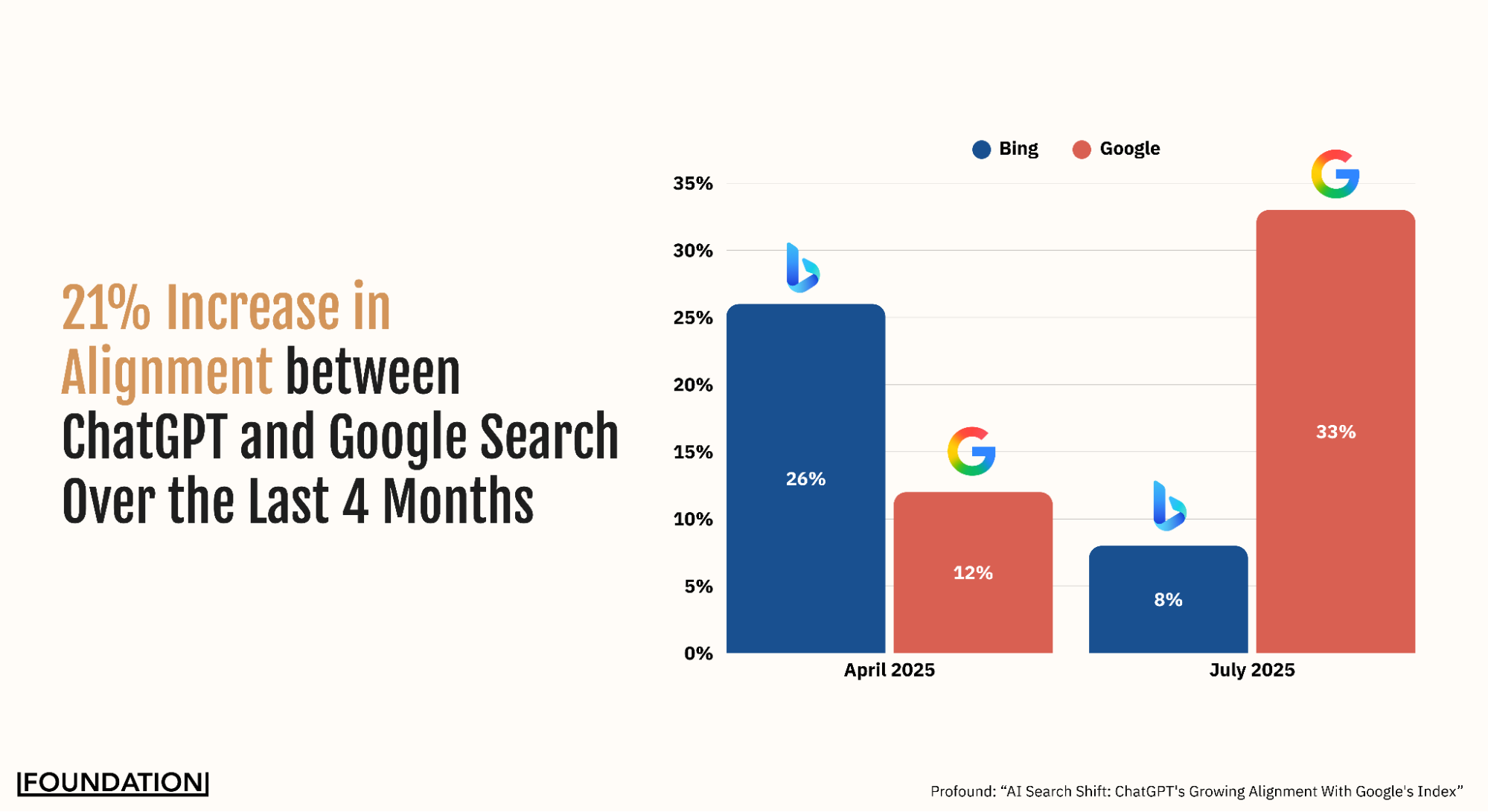
For brands, that makes tracking citations across AI tools a key part of generative engine optimization (or answer engine optimization, if you prefer).
Tracking AI Mentions, Prompts, Citations, and Sentiment
The scale of ChatGPT’s reach makes it one of the most important channels to monitor for brand visibility.
One of the best ways to track how often AIs mention or cite your brand is through generative engine optimization tools like Profound, Ahrefs Brand and Radar, and Semrush’s AI toolkit.
Let’s use Profound’s platform to illustrate which of these AI metrics you need to prioritize.
AI Mentions
Mentions are any appearance of a brand name within an AI’s responses. They can occur in direct recommendations, industry summaries, or comparative overviews. Tracking them over time can reveal how consistently a brand is included in relevant conversations and how its presence changes as the model evolves.
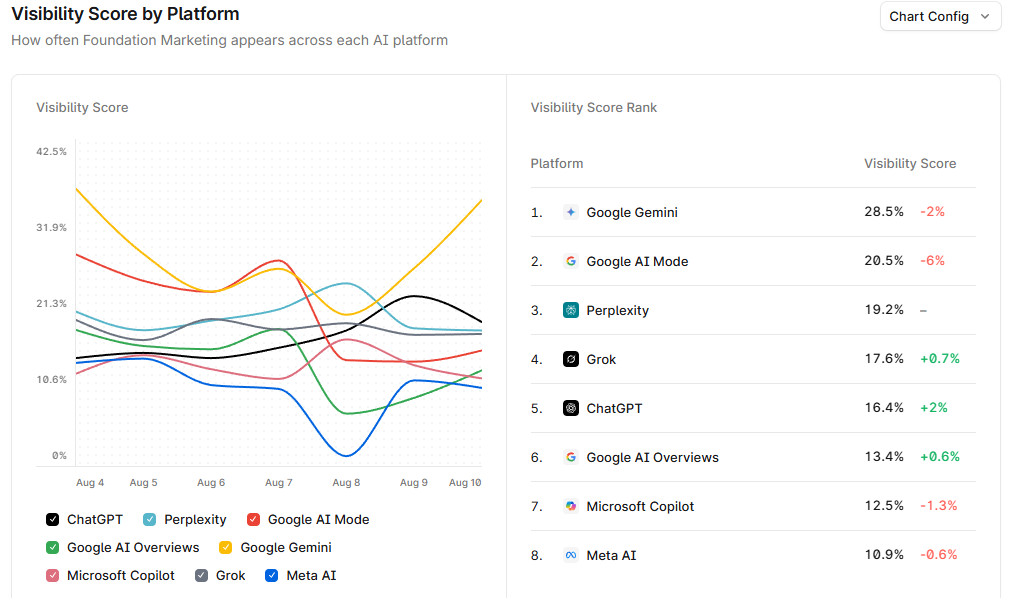
Citation Share
Citation share takes things a step further than pure brand mentions and shows how often specific AI tools include URLs to your content in their answers. Considering how volatile AI citations are, tracking these numbers over time is the perfect way to identify how well your brand is performing across tools like ChatGPT.

Sentiment Analysis
It’s all well and good to be mentioned by AI engines, but what if the context of that answer is mostly negative?
Sentiment reflects the tone of a brand’s portrayal in AI answers, whether the framing is positive, neutral, or negative. Observing sentiment patterns can highlight shifts in perception and signal how brand narratives are being shaped in generative search environments.
Tools like Profound can also highlight the most common details within those answers, making it easier to see which elements of your messaging are getting through and where they may fall short.

Prompt Tracking
Prompts are the questions and instructions that lead to brand mentions. Different prompts can trigger wildly different responses about your brand, even from the same AI model. Tracking them can offer insight into how people think about a brand or product category, the language they use to describe it, and the situations that bring a brand to mind.
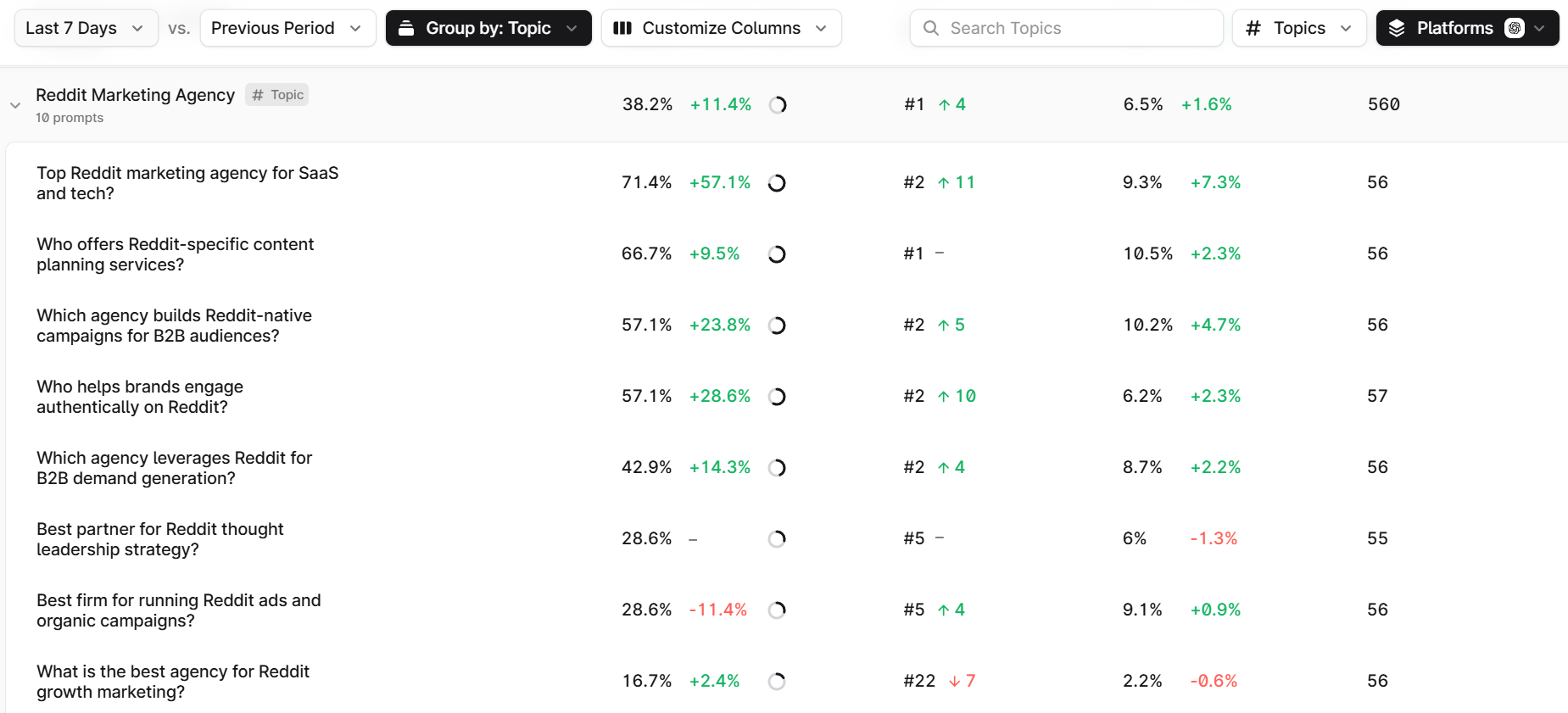
The most sophisticated tracking tools can even show you prompt variations that consistently exclude your brand, helping you identify gaps in your generative engine optimization (GEO) strategy.
The Importance of Cross-Platform Visibility
ChatGPT is just one piece of the puzzle. Claude, Gemini, Perplexity, and Grok all have different training data, retrieval methods, and citation behaviors. That’s why it’s important to track these metrics across different AI platforms. What works on ChatGPT might completely fail on Claude. Your brand might dominate Perplexity results but barely register on Gemini.
With GEO tools like Profound, Ahrefs Brand and Radar, or Semrush’s AI toolkit, you can monitor and compare brand performance across all major AI platforms.
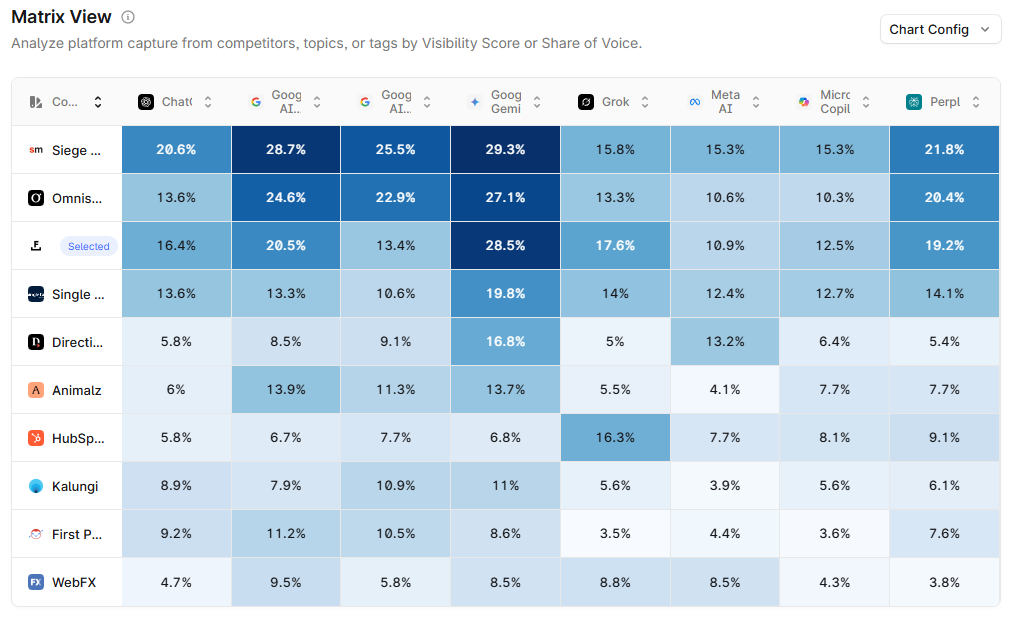
As AI search grows, it will increasingly influence purchase decisions. Getting ahead of this trend now means better brand visibility when AI-powered search becomes the default for your customers.
The Real Lesson from GPT-5’s Rocky Launch: Keep Your Finger on the Pulse
GPT-5 packs more speed, brainpower, and tools into one system, and it’s already changing how people find and see information. The launch also showed how fast the mood can swing when features change, proving that trust is just as important as what the tech can do.
The companies getting ahead of this transition aren’t waiting for OpenAI to fix their messaging or for the tools to mature. They’re setting up tracking systems now, experimenting with GEO, and building the infrastructure to monitor their AI visibility across platforms.
Don’t sit around for the next update. Start tracking your AI performance now and build a content marketing strategy that works for both SEO and GEO. Let your competitors argue over how many letters are in strawberry while you win the clicks.







